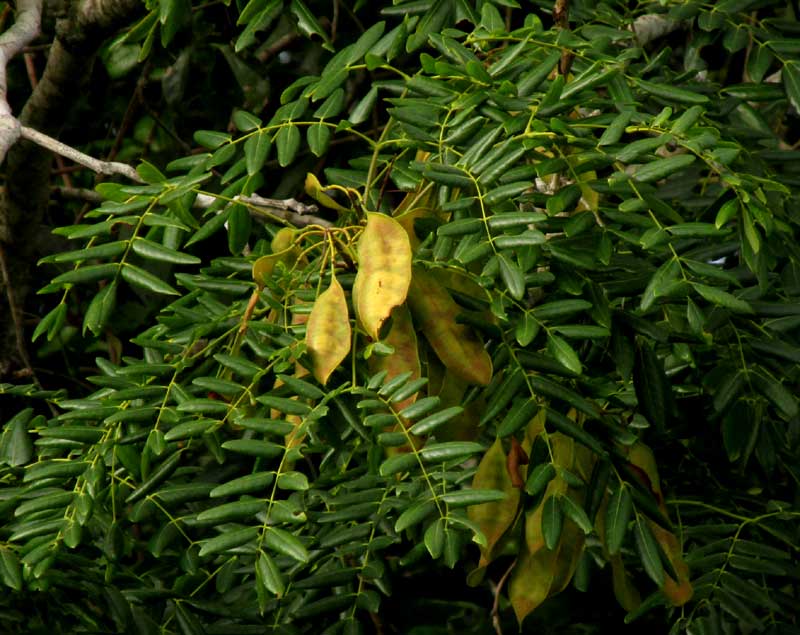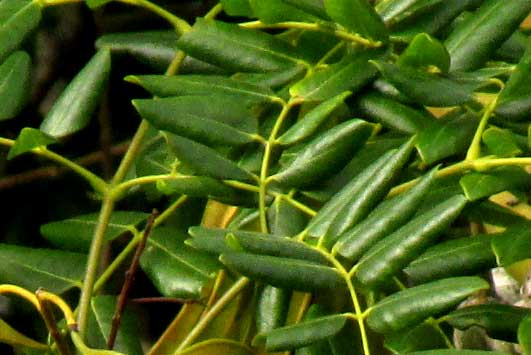Excerpts from Jim Conrad's
Naturalist Newsletter
from the July 13, 2018 Newsletter with notes from a camping trip the previous week in southwestern Campeche state, MÉXICO
ALBIZIA GUACHAPELE TREE
During my recent camping trip to southwestern Campeche state, on the morning of July 2nd I emerged from the woods near the entrance to Chicanná ruins, and began hiking eastward on the main highway between Chetumal and Escárcega. There at the southernmost extreme of the Yucatan Peninsula I was hoping to see plants and animals not encountered in the more arid northern part of the Peninsula. Within a few minutes, something new did turn up at the forest's edge, right beside the road. It was a fair-sized tree loaded with almost mature legume-type fruits, as shown below:

Several Bean Family species produce broad, flattish pods like that, but notice the leaves. The small, oval blades lined up opposite one another along slender, yellowish stems are leaflets, not leaves. Moreover, the drooping feather-like structures bearing the paired leaflets don't themselves attack to a woody branch, but rather to yet another slender, yellowish stem. The tree was inaccessible to pulling down leaves for a closer look but, below, a telephoto image shows a couple of points where the yellowish stems join:

So, this tree bears twice-compound leaves -- sometimes referred to as pinnately decompound leaves. In other words, each leaf is divided into segments, and then those segments are divided into further segments, in which case the ultimate blades are referred to as "pinnules," and each pinnule arises from a stemlike "rachilla."
Even though a fair number of Bean Family trees possess such decompound leaves -- the acacias and mimosas, for instance -- the Bean Family is so huge, and most of its species bear either non-compound or once-compound leaves, that during the identification process, noticing this feature helps whittle down the possibilities a lot.
Identification normally is much easier with flowers than with fruits, but fruits were all we had, so I took the close-up of a large fruit cluster, shown below:

The flattish legumes bearing several beans in each pod, and with the legume's edges thickened into wire-like seams, looked like certain species of the genus Albizia -- for example, the Lebbeck Tree, Albizia lebbeck, much planted in Yucatan's towns and cities, shown at www.backyardnature.net/n/10/100418ac.jpg
Scanning the Yucatan's listed Albizia species, a species turned up matching our roadside tree fairly well, and it was a good one, one not found in the Yucatan's arid northern parts. It was ALBIZIA GUACHAPELE, by some experts called Pseudosamanea guachapele*, distributed from Ecuador in South America, through Central America (mostly on the Pacific slope), with a somewhat isolated population turning up in northern Guatemala and northern Belize, and just nudging into Mexico's extreme southern Yucatan Peninsula. This was a good beginning for my Campeche wanderings.
Though Albizia [Pseudosamanea guachapele is little known in the English speaking world and bears no English name, it's highly regarded in countries where it does occur. It's a good-size tree often growing up to 20m tall (65ft), exceptionally to 50m (165ft). Growing fast and producing a spreading, rounded crown, it's a favorite shade tree. Its leaves make excellent forage, containing 24% protein. Its wood is of good quality for construction, and the trees are much cut for that purpose. The trunk consists of an unusually large amount of heartwood, which is a uniform yellowish-brown or rich brown with a a golden luster, and traditionally has been used for making a golden dye.
The species needs much sunlight, but thrives in a variety of well-drained soil conditions, from sandy loam to gravel and rocky. At Chicanná the soil was developed atop limestone.